Today I bring you a car that is certainly in the memory of many of us gearheads, especially those who grew up with games like Gran Turismo and DiRT. But before talking about the creature, nothing is fairer than first getting to know the creator.
Nobuhiro “Monster” Tajima
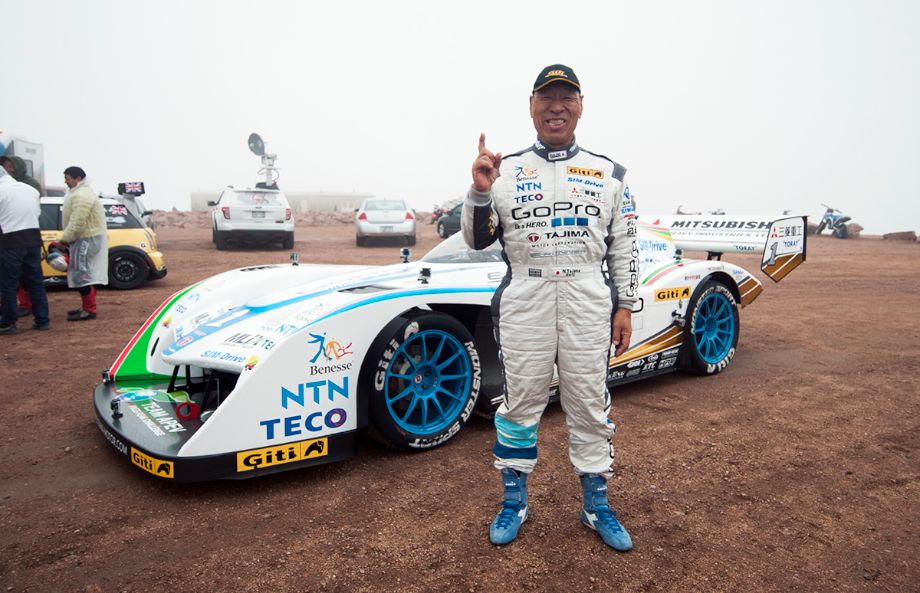
Born in 1950, Tajima grew up in a rural area and learned to drive on gravel roads, honing the skills he would later use during his rally career, which began in 1968 at a regional event. Due to his height (1.83 meters tall) and aggressive driving style, uncommon among Japanese racers, the driver would soon receive from an Australian newspaper the nickname that would accompany him throughout his career: Nobuhiro “Monster” Tajima, a legitimate Japanese kaiju from the rally tracks.
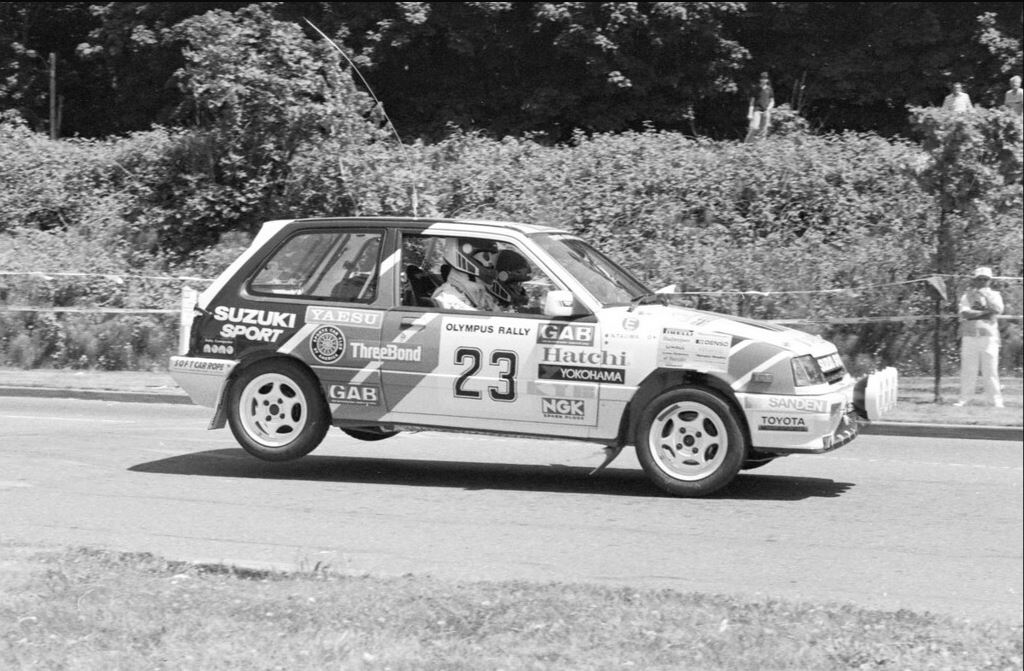
In 1983, Tajima founded Monster Sport, a shop specializing in the tunning and support of Japanese cars for rally competitions. The good work drew Suzuki’s attention, and led to a partnership that transformed the team into Suzuki Sport, starting to work in the development, manufacture and assembly of the automaker’s competition vehicles. In addition to Pikes Peak, another highlight of the Japanese driver’s career are the 9 titles won in the All Japan Dirt Trial Championship, a kind of Japanese Time Attack raced on Rallycross-style tracks.
After participating in various sports such as WRC and Pikes Peak, the partnership between Monster Sport and Suzuki was ended, and the company is now part of Tajima Motor Corporation, a conglomerate of which Tajima is CEO and which, among other activities, has dealerships of brands such as Porsche, Lamborghini, Aston Martin, Suzuki, Peugeot and Citröen for all of Japan, in addition to acting in the development of kits and aftermarket components for models from various automakers and in the development of electric propulsion vehicles.
The Monster vs Pikes Peak
While things were going well on the business front, 1988 saw another important milestone in the history of the Japanese driver, who made his Pikes Peak International Hill Climb debut driving a “modest” Mazda 323 GTX to third place in the Showroom Stock division. Despite being a Group A car, the peculiarities of Pikes Peak made it clear that something more was needed, especially in a year marked by the victory of Ari Vatannen with the Peugeot 405 T16 (which resulted in the celebrated documentary Climb Dance).
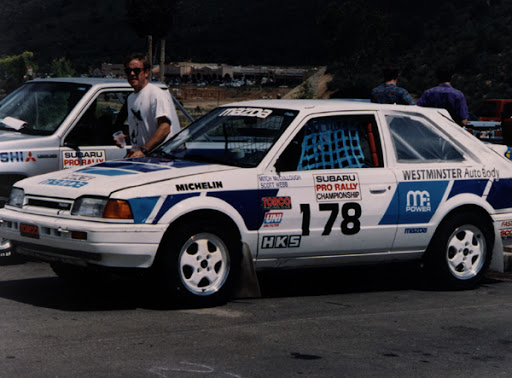
Taking advantage of the partnership with Suzuki, for the 1989 race Tajima brought a car developed by his team to the All Japan Dirt Trial Championship, a Japanese championship for sprint-type rally events. Although on the outside it resembled a Suzuki Cultus (also known as a Swift in some markets), it was actually a prototype with a tubular structure, equipped with two Suzuki G16 1.6 Turbo engines and two sequential transmissions (one for each axle), with a total combined power of 800 HP. In this configuration, the Japanese team got the third position in the qualifying rounds, however without being able to complete the race, a result that would be repeated in the following year.
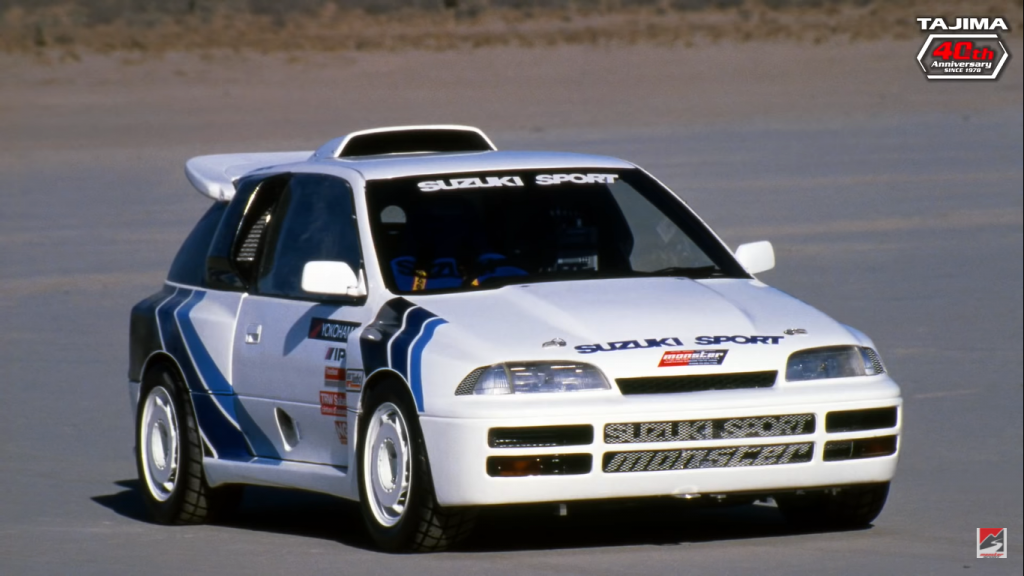
After the retirement of the previous year, for 1990 Suzuki’s option was for a softer version of the Cultus, based on the GT-i version but with a 1.6 Turbo engine and all-wheel drive, but the result was the same, with another DNF by the Suzuki team.
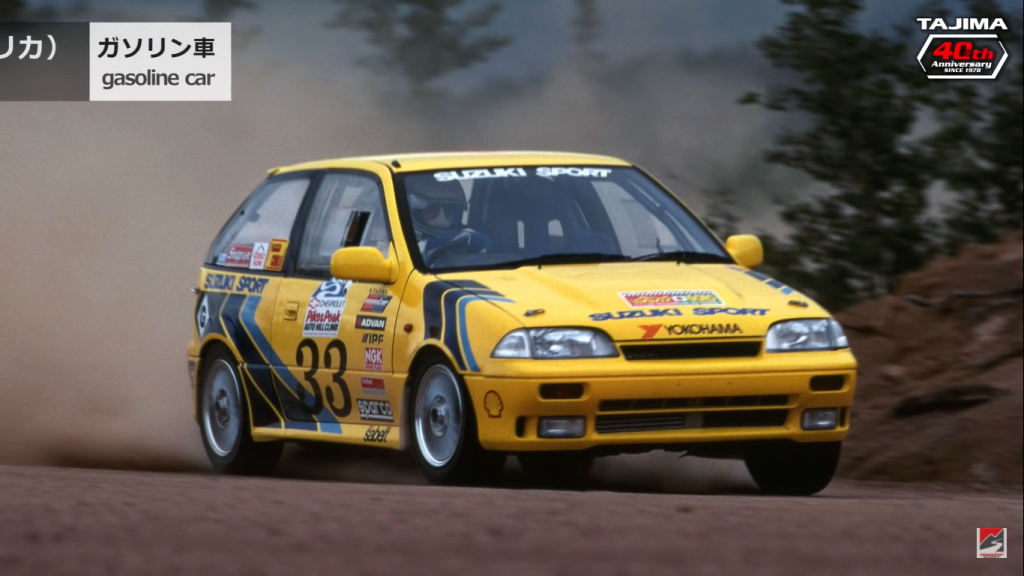
Seeking to face the single-seaters of the Open Wheel category, in 1991 Tajima returned to the two-engine configuration, now called SUZUKISPORT Twin Engine CULTUS TYPE 2. Together with several mechanical refinements, the new package began to bring results for the “Monster”. with a third place and two wins in the Unlimited category, culminating in the SPEC’93 version, which was also present in Gran Turismo 2.
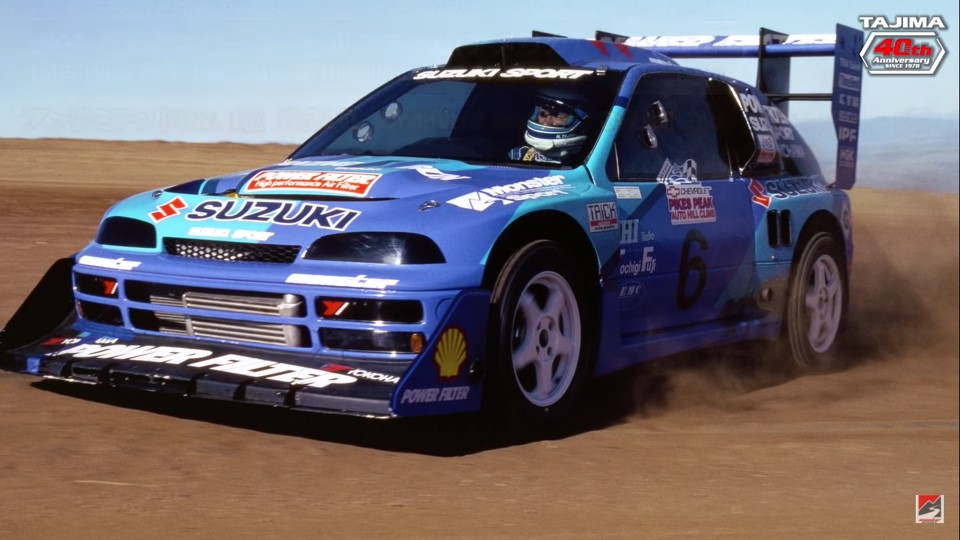
1.1 SUZUKISPORT Twin Engine Escudo SPEC’94
Even with the continuous evolutions applied to the Cultus, the victory in the overall classification continued to slip out of the hands of the Japanese team. Thus, a new car was developed by Suzuki Sport for the 1994 race, this time using the Suzuki Escudo silhouette as a base (also sold as Vitara in some markets). Perhaps the greatest curiosity of this first version is in the aerodynamics, as a two-element wing similar to the one used in the rear of the car was used at the front.
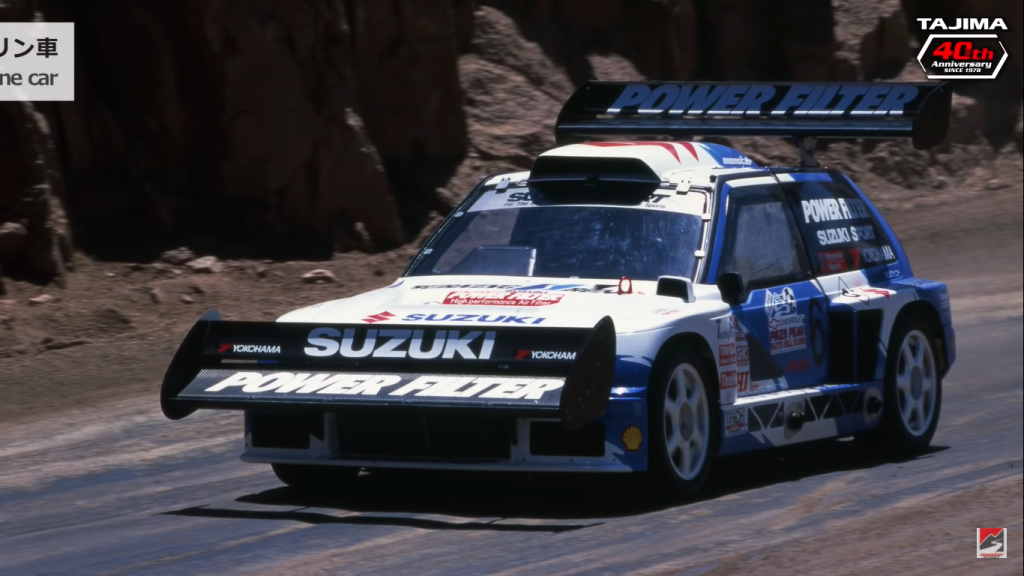
What Suzuki’s folks didn’t expect is that the competition would become even fiercer with the arrival of their Toyota compatriots and Rod Millen aboard the equally monstrous Celica Pikes Peak. Equipped with the same 2.1 engine used in Toyota’s GTP prototypes, and with extensive use of the ground effect, the Millen+Celica combo lowered the Pikes Peak record by around 40 seconds, with the 10m04s060 mark that would only be broken more than one decade after being established. Again it would not be Suzuki’s turn, relegated to second place in the Unlimited category and fifth place in the overall standings.
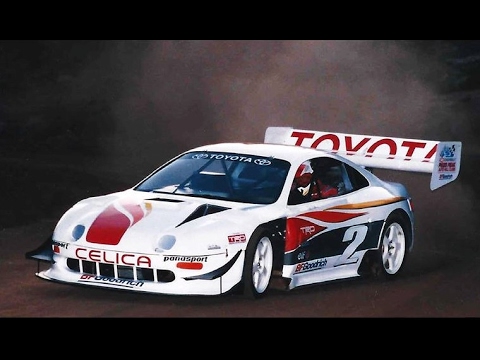
Tech Analysis
The first version of the Pikes Peak Escudo built over the know-how acquired from the Cultus’ victories in previous years. Like a NASCAR Cup car, only the external body shape resembles that of the production model, as the car’s chassis is a tubular structure in chrome-moly-molybdenum steel designed specifically for the car.
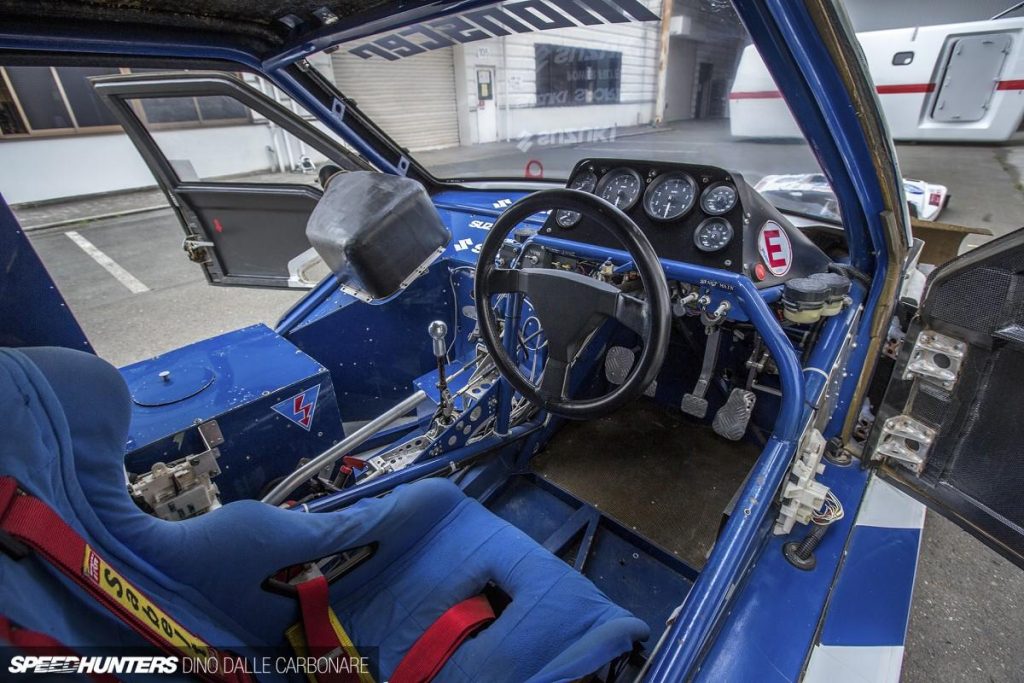
Like all Japanese cars, the driver is positioned on the right, while the fuel tank is located next to the driver, helping to distribute the car’s weight. But the big highlight is really the Powertrain, with two G16A engines installed in transverse position, one for each axle of the vehicle. Equipped with turbochargers and air-water heat exchangers, the small 1,590 cm³ engines produce around 400 hp individually, and each has its own sequential transmission and limited-slip differential with electro-magnetic control. To transfer power to the road, Yokohama off-road tires 285/680 R17 are used, mounted on 17”x10” SSR wheels.
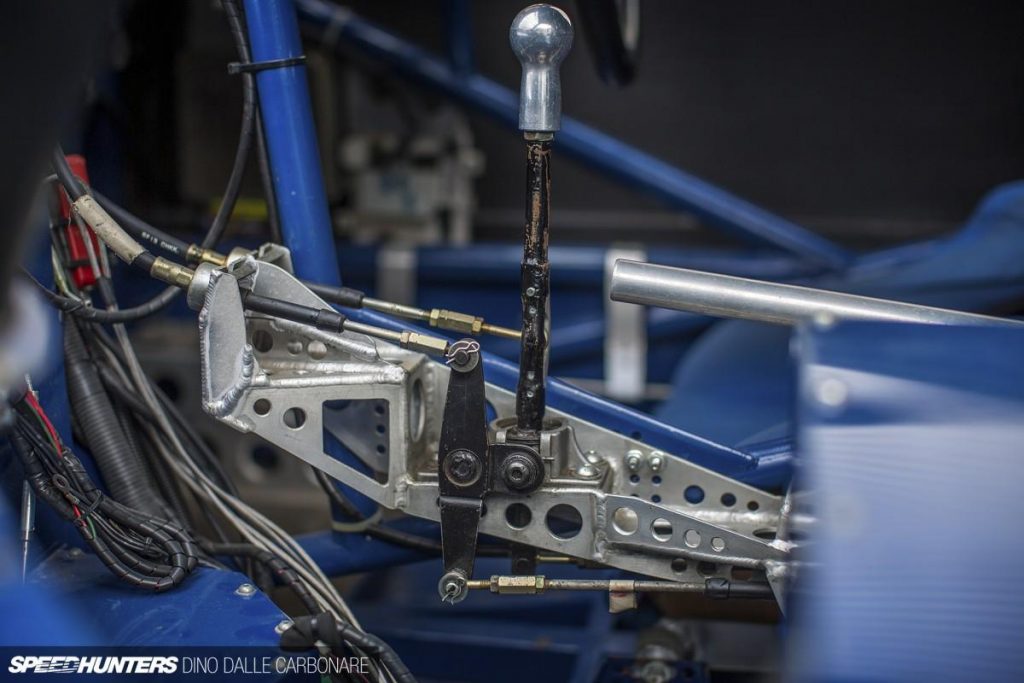
More surprising is the fact that all the controls (throttle, clutch and gear selection lever) are unique and work in perfect synchronism, a big challenge when considering that both the throttle and clutch are mechanically linked to the pedals and must have the same curve to ensure the prototype’s drivability.
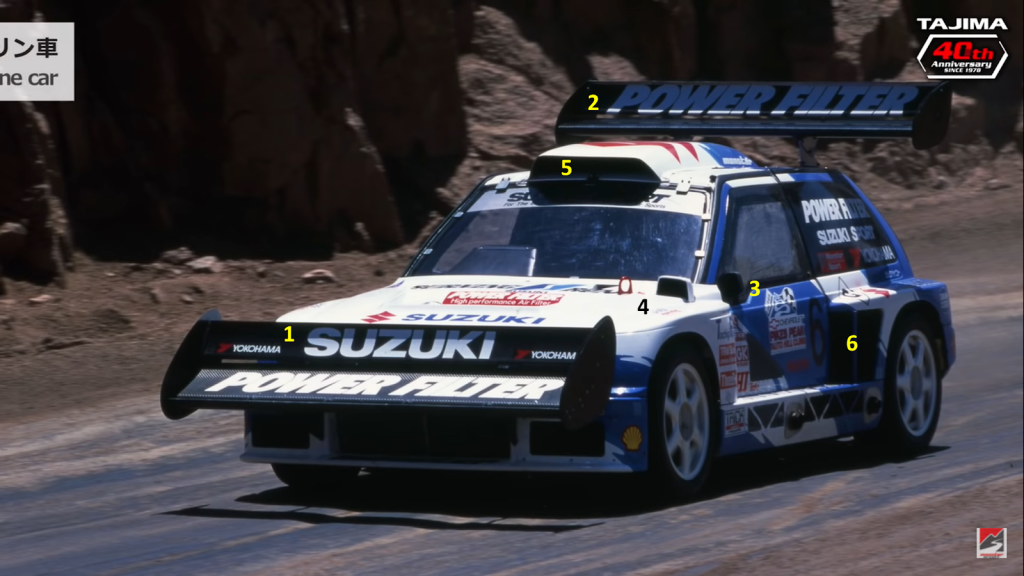
As for the prototype bodywork, it is mainly made of carbon fiber, and kevlar was used on the floor and other areas where greater mechanical strength was needed. In the 1994 version, the first highlight is the two-element airfoils used in the front (1) and rear (2), a solution similar to the one used by Tajima in the Cultus used in the 1994 All Japan Dirt Trial Championship (image below). Another interesting feature is the air intake for the front engine (3), which at first glance looks like a rear-view mirror with inverted mounting, as well as an air intake over what would be the hood (4). The air intake for the rear engine (5) was originally mounted on the roof, in a solution similar to that of the Cultus, and the air intake for the rear heat exchanger is positioned right in front of the rear wheel (6).

1.2 SUZUKISPORT Twin Engine Escudo SPEC’95
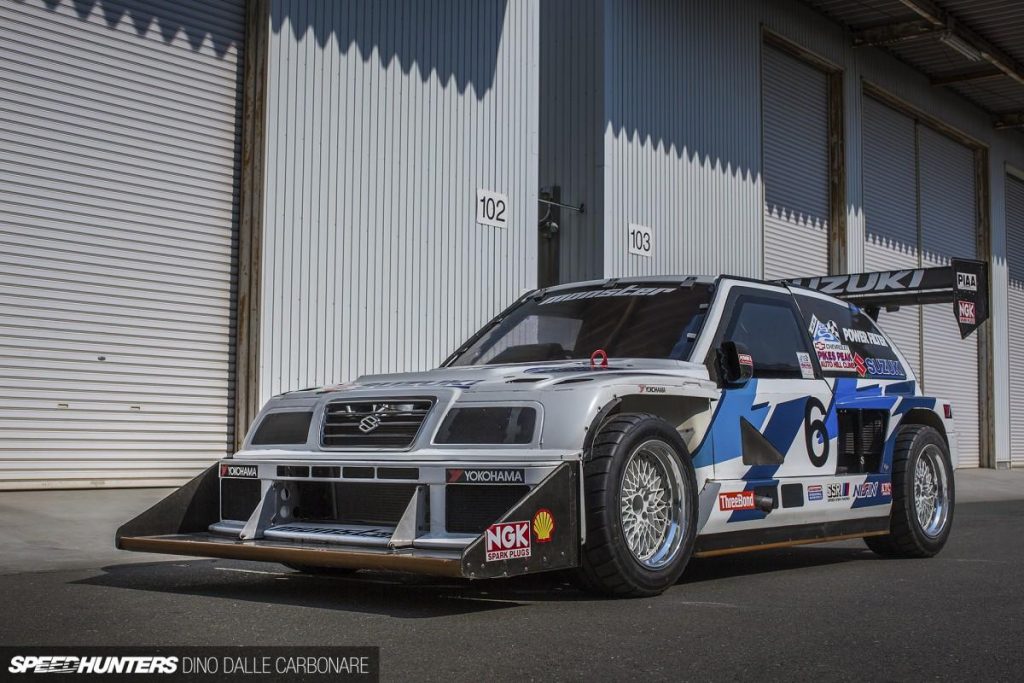
After breaking the record in 1994, the 1995 race couldn’t be more different, as a week of rain and blizzards forced a reduction in the route, with the finish line moved to the stretch known as Devil’s Playground. Throughout the week of training, Rod Millen dominated the leaderboards, taking pole position for the starting sequence, and during the race he managed to get a 5 second advantage in the intermediate part. But to everyone’s surprise (including the American narrators), Tajima majestically led the final stretch to victory in the overall standings, with a time of 7.53s00 and beating Millen’s Toyota by just 7-tenths of a second.
Tech Analysis
With the performance level of the Toyota Celica de Millen, it was clear that something more was needed for Suzuki to have a real chance of winning. For this, a complete overhaul of the aerodynamics was carried out, starting with the front, which received a gigantic splitter (7), in addition to small deflectors (8) to reduce aerodynamic drag. The wheel boxes were completely opened (9), always aiming to maximize downforce at the front.
Phase 2: Suzuki Escudo V6 Pikes Peak Special
For 1996, Suzuki and Tajima did not rest on their laurels. Realizing that the performance of the 1995 car was still not up to the Celica, a new car was developed, following similar precepts to the Toyota design. First, to simplify the mechanical design, a two-liter Suzuki V6 H20A engine was adopted, which with the help of two turbos produced 800 hp. Mounted in a central position, this engine transmitted its approximately 80 kgf.m of torque to the 4 wheels through a six-speed sequential transmission.
Thus, a new chassis was developed in aluminum was built, employing an all-aluminum spaceframe, technology patented by Monster Sport, resulting in a weight of only 800 kg, with 47/53 distribution.
2.1 Suzuki Escudo Pikes Peak Special SPEC’96
In this configuration, the new Escudo arrived in the United States with little track baggage, as it was a completely new car developed in less than a year. This resulted in a number of mechanical problems, so Tajima was forced to settle for second place in the class and overall, second only to Rhys Millen. In Tajima’s words:
“I did my best but it was a disappointing result. However, I was able to score this time despite this condition (mechanical problems). I believe the car’s high potential has been proven. Next year, I’m sure I’ll be able to win the race.”
Tech Analysis
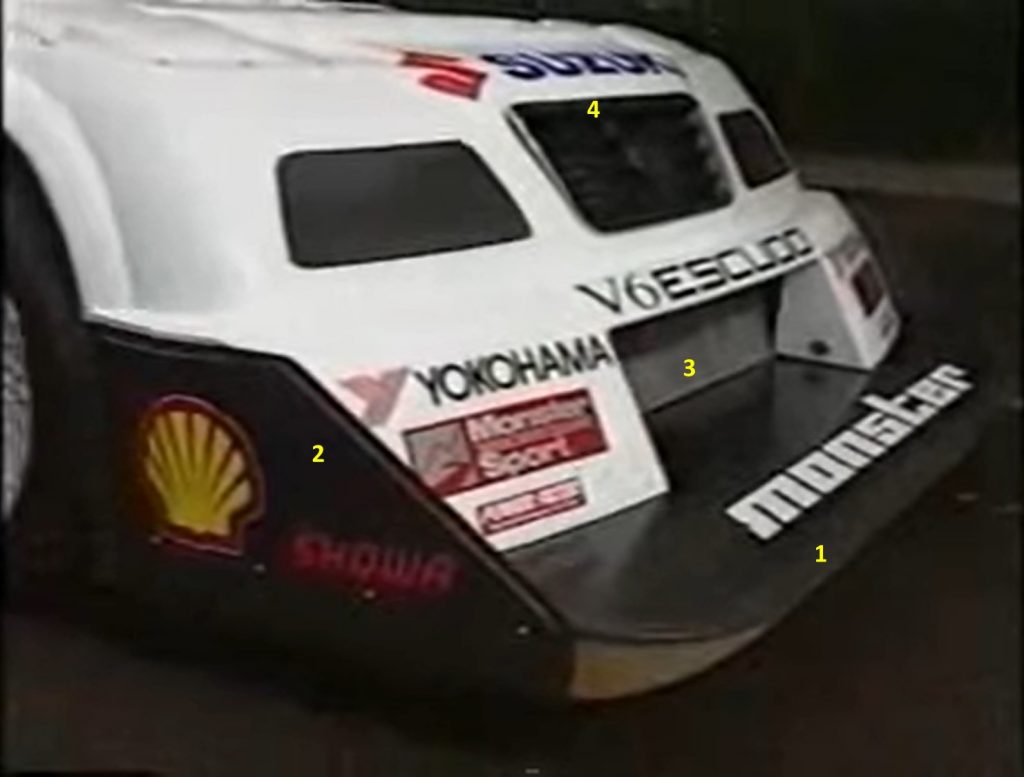
The front of the first version of the Pikes Peak V6 bodywork was marked by the huge front splitter (1), accompanied by sideplates (2) just as large. Furthermore, two air intakes could be seen, one in a lower position for the radiator (3) and an upper one integrated with the false grille (4), presumably for the intercooler.

Barely visible in this image, the front section of the Escudo still had large louvers (5) over the wheel housings and an opening to vent hot radiator air (6). These details remained virtually unchanged during the life of the prototype, and we’ll be able to see them more clearly below.
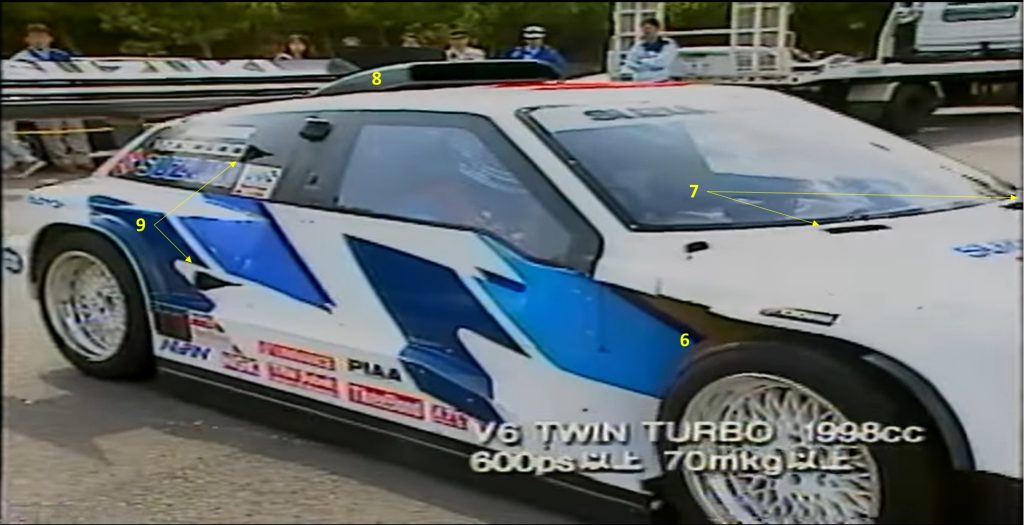
Moving on to the center section, the front wheel housings are ventilated through large longitudinal openings (6), and two small air intakes (7) help to cool the cabin. The air intake for the twin-turbo V6 engine is positioned over the roof (8), and NACA ducts (9) carry air to cool the rear brakes and oil coolers.
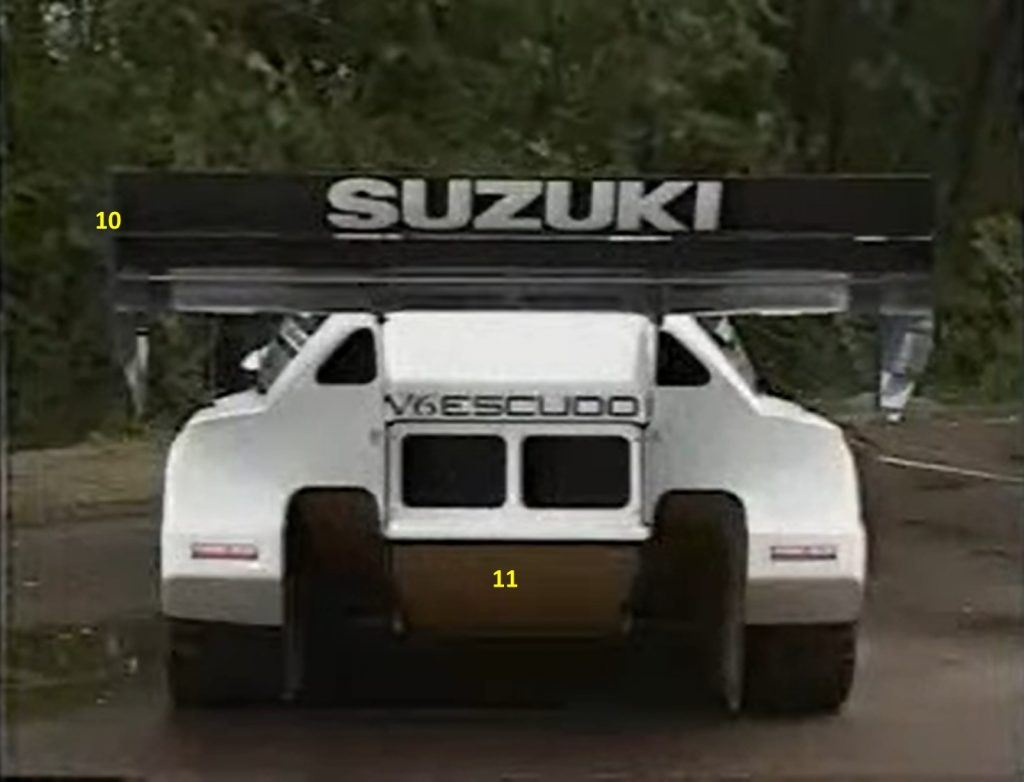
The rear view of the car, perhaps the most recognizable to Gran Turismo gamers, is dominated by the 3-element rear wing (10) and massive Kevlar coated diffuser (11).
2.2 Suzuki Escudo Pikes Peak Special SPEC’97
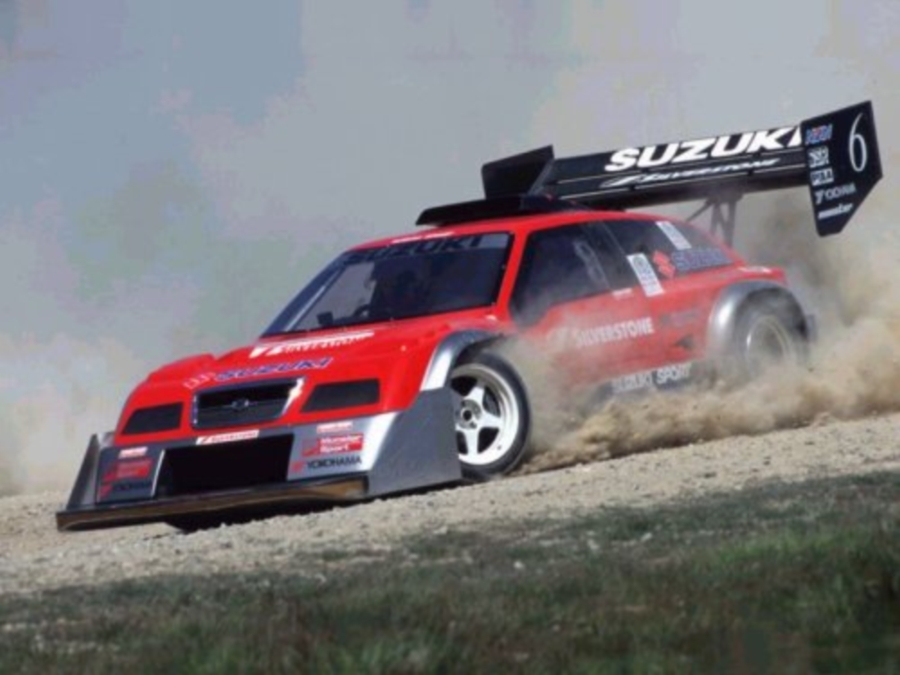
For 1997, the base of the previous year was maintained, with some updates. First, the engine was replaced by one based on the H25A, with a displacement of 2,493 cm³, new intake and intercooler piping layout, electronic wastegate and equipped with Suzuki’s IMF anti-lag system. In this configuration, the Escudo now had an impressive 995 hp at 8,100 rpm and 95 kgf.m of torque at 6,500 rpm.

In addition to the engine, the aerodynamics were updated with a complete redesign of the front splitter, which grew 30% in length, resulting in an increase in total length from 4870 mm to 5050 mm. In the image below we can also see that the air intakes for the front brakes are positioned next to the radiator air intake.

To handle the additional horsepower, the front brakes were upgraded to 8-piston callipers, and the tires grew from 285/660 R17 on all four wheels to 290/680 R17 at the front and 330/680 R17 at the rear. Despite the improvements implemented, a mechanical failure with approximately ⅔ of the path traveled resulted in an abandonment.
2.3 Suzuki Escudo Pikes Peak Special SPEC’98
The year 1998 would see two challenges for the Japanese: in addition to the race at Pikes Peak, they would face their “arch nemesis” Rod Millen in the Queenstown Gold Rush, a Hill Climb race held on April 13 in New Zealand. For the first time, Tajima and the V6 Escudo beat Millen, setting the record of 8m13s60, promising to intensify the dispute in Colorado.
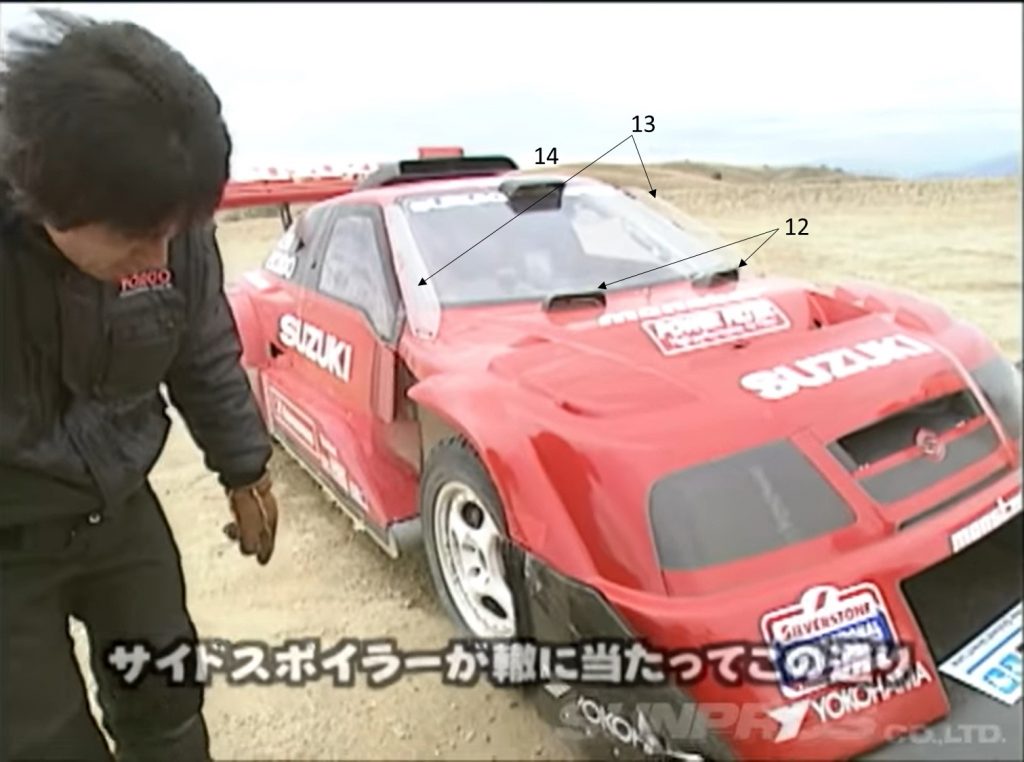
Several new features were implemented in the Escudo SPEC-98 , starting with the air intakes (12), which became sort of a scoop over the “hood”. Two fences (13) were also added near the windshield, to prevent the airflow from migrating. Finally, an air intake over the windshield (14) was added, with unknown function. In this image we can also see in greater definition the louvers and central opening for radiator ventilation.
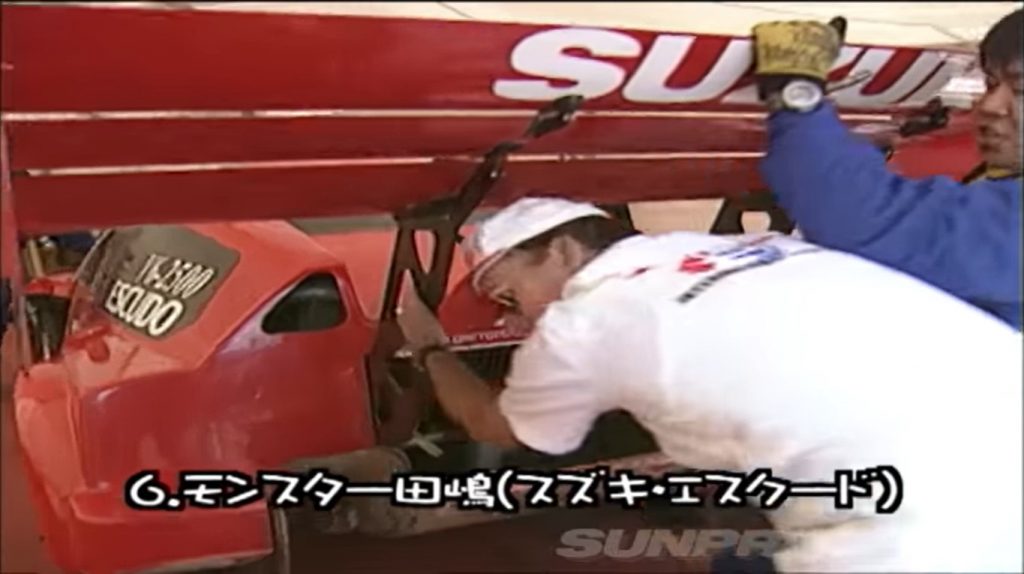
At the rear, the diffuser and wing seem to have remained unchanged, with the exception of the wing support, which is no longer massive and now has reliefs throughout its entirety.
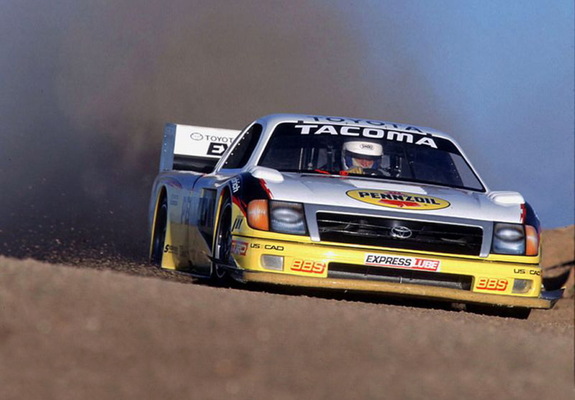
However, Millen did not stay put and brought a new prototype, the Toyota Tacoma Pikes Peak, a car far superior to the Celica he had been racing since 1994. Such was the superiority that, even with the bad weather, the Kiwi was very close to breaking the record of the race, with the mark of 10m07s70, while Tajima took the second position with the mark of 10m32s57 after his attempt was compromised by the worsening of the weather in the first half of the route.
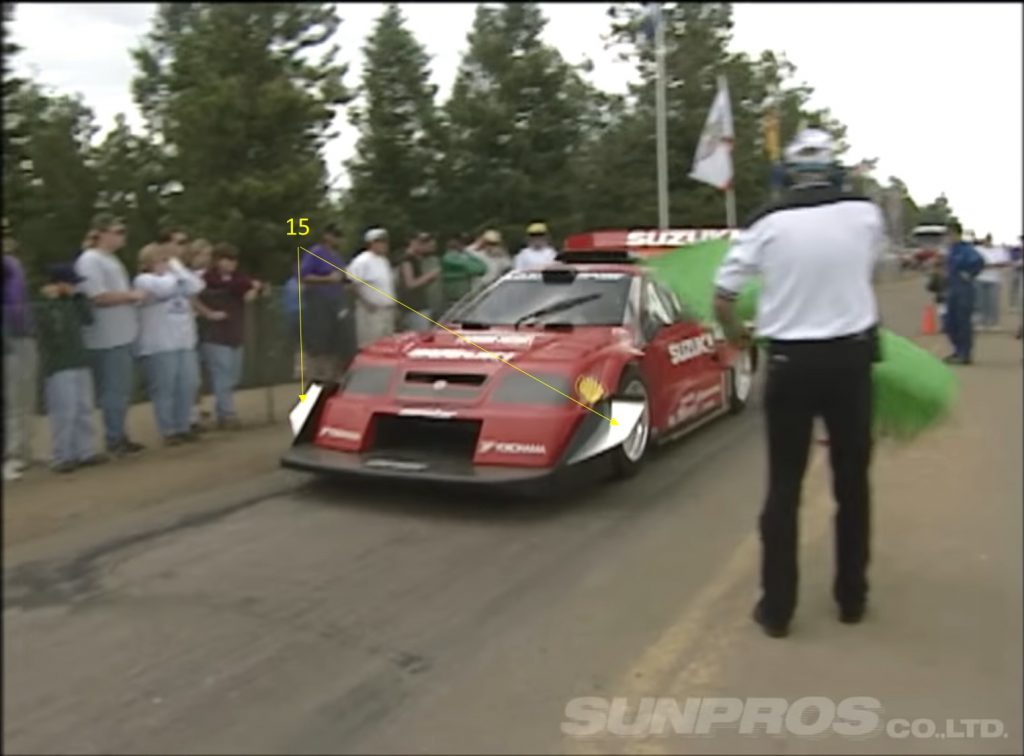
In comparison to the setup that had competed in New Zealand, the Escudo came to Pikes Peak with two gigantic canards (15), each equipped with a gurney flap, in addition to the necessary windshield wiper to handle the race’s weather conditions.
2.4 Suzuki Escudo Pikes Peak Special SPEC’99
The year 1999 would see Tajima again face the Race to the Sky and Pikes Peak duo, and once again competing versus Rod Millen. The New Zealander chose to bring the old Celica to the New Zealand race, where a flat tire resulted in an easy victory for the Japanese team. At Pikes Peak, the situation was reversed. Again with the Tacoma pickup, Millen got the first position in training, which gave him the right to choose the starting moment.

With an unstable climate, the Kiwi driver chose to be the first to start, scoring 10m11s35. Again, the mountain was not in Tajima’s favor, and during his attempt a strong headwind resulted in damage to the front fairing, reducing visibility and forcing Tajima to reduce his pace, getting a time of 10m37s35, disappointing but still sufficient for the second overall position in the test.
2.5 Suzuki Escudo Pikes Peak Special SPEC’00
In 2000 the duo Escudo / Tajima would only see action in Race to the Sky, while for Pikes Peak a Cultus with two J18A engines and a combined total power of 800 HP would be used. In the New Zealand race, Suzuki’s once again achieved victory over Rod Millen, which now competed with a Toyota Tundra similar to the pickup trucks that compete in races like the Baja 1000.

The Escudo’s aerodynamic updates for this year were limited to more aggressive canards up front.
According to information at the time, in this configuration the car has a Cl of 4.2, with a Cd of 1. In the mechanical part, narrower 215/75 R16 tires were chosen.

2.5 Suzuki Escudo Pikes Peak Special SPEC’01
The year 2001 marks the farewell of the Escudo Pikes Peak from competition. With the first generation Escudo already out of the production line for a few years now, it made little sense for Suzuki to continue to compete with a model that was no longer manufactured. Thus, for Race to the Sky, a new car was developed, based on the second generation of the Vitara/Escudo and in the style of the cars that competed in the All Japan Dirt Trial Championship.

For Pikes Peak, Tajima also appeared with a new car, based on the silhouette of the compact hatch Aerio/Liana for Nobuhiro Tajima.

Still, the Escudo made its last appearance on Pikes Peak driven by Yutaka Awazuhara. In this latest appearance, the car received some upgrades, now with an H27A engine with 2,736 cm³ of displacement, recalibrated anti-lag system and 335/30 ZR17 tires, to better adapt to the mixed paving of dirt and asphalt. In aerodynamics, the only noticeable change was the addition of two scoops above the roof.

Without Toyota present, this time Suzuki was the favorite for a one-two, which materialized in the training sessions, dominated by the Japanese. During the race, Tajima set a strong pace with the new Aerio P950 Pikes Peak, but a mechanical failure led to an abandonment with one mile to the finish line. Yutaka Awazuhara however had better luck with the oldEscudo, and got fourth place overall, and the victory in the Unlimited category.
Results
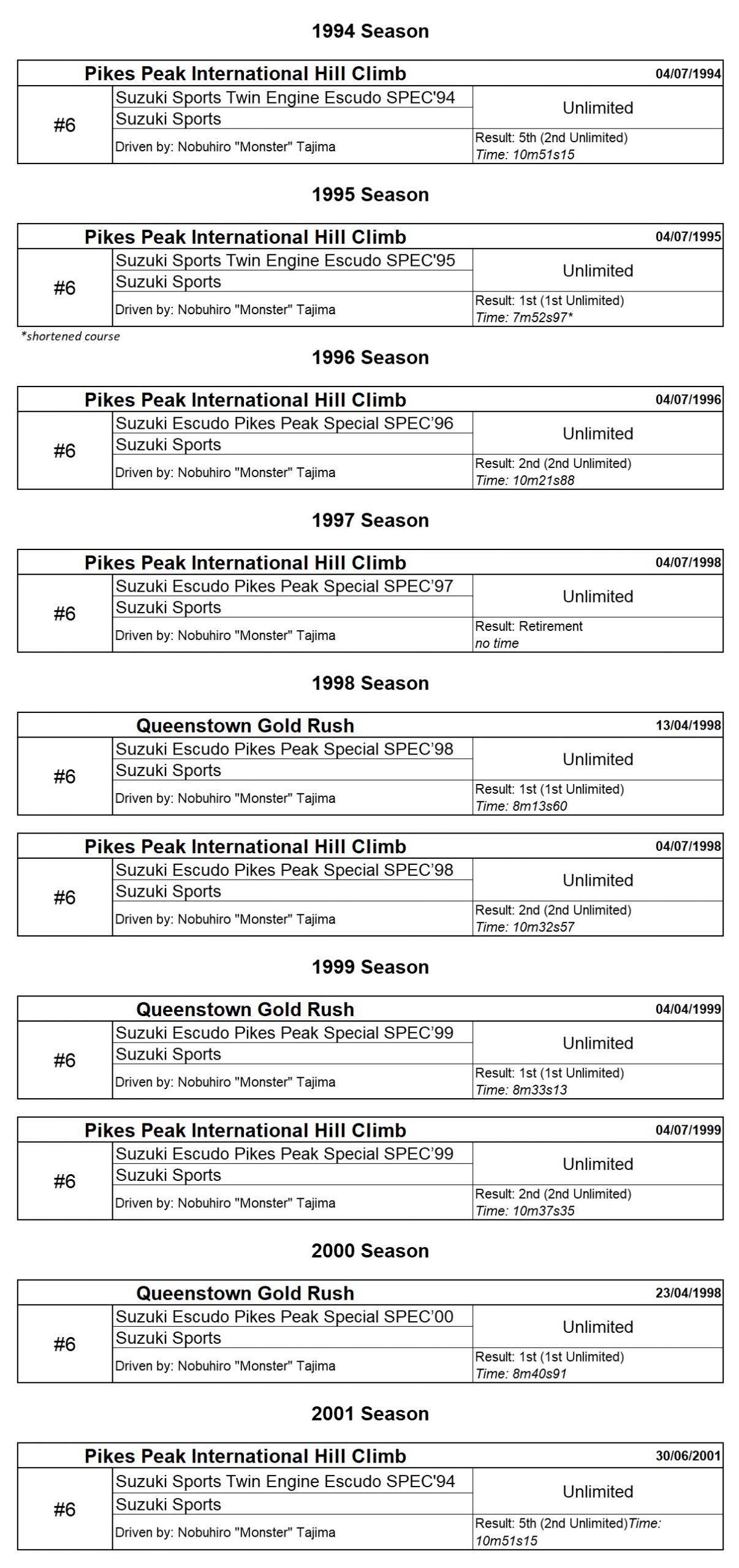
Images:
[1]: 2013 E-RUNNER Pikes Peak Special – Nobuhiro Tajima. Source: https://sportscardigest.com/pikes-peak-hill-climb-2013-report-and-photos/2013-e-runner-pikes-peak-special-nobuhiro-tajima-5/.
[2]: Flying Suzuki. Fonte: https://www.flickr.com/photos/jimculp/7338859804.
[3]: モンスター田嶋 パイクスピークヒルクライム ヒストリー モンスタースポーツ MONSTER SPORT. Source: https://www.youtube.com/watch?v=DHhAfBeXwPE.
[4]: Toyota Celica Pikes Peak // Rod Millen Dirt Record. Source: https://www.youtube.com/watch?v=zEjRq-VGjKw.
[5]: Twin-Engined & Terrifying: A Monster Suzuki. Source: http://www.speedhunters.com/2014/04/twin-engined-monster-suzuki-escudo/.
[6]: GTOの神vsモンスター ’94全日本ダートラDクラス 丸和. Source: https://www.youtube.com/watch?v=ZFOxn-rXxyc&t=180s.
[7]: All Aluminum Space Frame. Source: https://www.suzukisport-racing.com/english/product/al_frame/al_frame.html.
[8]: PIKESPEAK 1996 #1. Source: https://www.youtube.com/watch?v=g6mnauKMu9s.
[9]: 1997 Escudo Pikes Peak Special ’97 Information. Source: https://www.suzuki.co.jp/dom4/motor/97/pk75a.htm.
[10]: Toyota Tacoma Pikes Peak 1998 pictures. Source: https://www.favcars.com/toyota-tacoma-pikes-peak-1998-pictures-187729.
[11]: Suzuki NEW Escudo 2nd overall! Source: https://www.suzuki.co.jp/dom4/motor/99/ahc2.htm
[12]: New machine “Suzuki Sports Twin Engine Cultus” debuts! !!. Source: https://www.suzuki.co.jp/dom4/motor/00/2000/qt00_cltus.html
[13]: more evolved “Suzuki NEW Escudo Pikes Peak Special”! Source: https://www.suzuki.co.jp/dom4/motor/00/2000/qt00_escud.html.
[14]: RACE TO THE SKY Final. Source: https://www.suzuki.co.jp/dom4/motor/01/qtgr/8-2.htm
[15]: Suzuki Pikes Peak Challenge 2001. Source: https://www.suzuki.co.jp/dom4/motor/01/pikes/index.htm.
Sources
Japanese ‘Monster’ tackles Pikes Peak. Source: https://www.wheels.ca/news/japanese-monster-tackles-pikes-peak/
Nobuhiro Tajima. Source: https://www.historicracing.com/driverDetail.cfm?driverID=5351
Nobuhiro Tajima. Source: https://www.tajima-motor.com/e/ceo.html
SUZUKI’S TWIN ENGINE PIKES PEAK MONSTERS. Source: https://drivetribe.com/p/suzukis-twin-engine-pikes-peak-RjQnD9dwQxuR9PQ-v7Kh9A?iid=BF6zmnOmQn6_ckaucj-N3Q
Twin-Engined & Terrifying: A Monster Suzuki. Source: http://www.speedhunters.com/2014/04/twin-engined-monster-suzuki-escudo/
Suzuki’s Challenge to Pikes Peak and Its Evolution: History of Suzuki Pikespeak challenge. Source: https://www.suzuki.co.jp/dom4/motor/01/pikes/history.htm
Executives. Source: https://www.apev.jp/en/aboutus/profile.html
74th PIKES PEAK AUTO HILL CLIMB. Source: https://www.suzuki.co.jp/dom4/motor/96/autohill.htm.
’96 “Suzuki Escudo Pikes Peak Special”. Source: https://www.suzuki.co.jp/dom4/motor/96/autohil2.htm
1997 Escudo Pikes Peak Special ’97 Information. Source: https://www.suzuki.co.jp/dom4/motor/97/pk75a.htm
1997 Escudo Specification. Source: https://www.suzuki.co.jp/dom4/motor/97/pk75b.htm
1998 Queenstown Gold Rush International Auto Hill Climb “RACE TO THE SKY” Bulletin! Source: https://www.suzuki.co.jp/dom4/motor/98/ahc1.htm
1998 Breaking news of Pikes Peak results! Source: https://www.suzuki.co.jp/dom4/motor/98/ahc2.htm
2nd Queenstown Gold Rush International Auto Hill Climb: Escudo achieved overall victory for the second consecutive year! Source: https://www.suzuki.co.jp/dom4/motor/99/ahc1.htm
The 77th Pikes Peak International Hill Climb: Suzuki NEW Escudo 2nd overall! Source: https://www.suzuki.co.jp/dom4/motor/99/ahc2.htm
2000 Queenstown Gold Rush International Auto Hill Climb Bulletin: Suzuki Escudo achieved overall victory for 3 consecutive years! Source: https://www.suzuki.co.jp/dom4/motor/00/ahc1.htm
SPECIFICATIONS: SUZUKI NEW ESCUDO PIKES PEAK SPECIAL. Source: https://www.suzuki.co.jp/dom4/motor/00/2000/qt00essp.html
Suzuki Pikes Peak Challenge 2001. Source: https://www.suzuki.co.jp/dom4/motor/01/pikes/machine.htm
Suzuki Grand Vitara Pikes Peak Special Specifications. Source: https://www.suzuki.co.jp/dom4/motor/01/pikes/spec2.htm
Video
1994 Pikes Peak International Hill Climb:
1995 Pikes Peak International Hill Climb:
SUZUKI ESCUDO PIKES PEAK SPECIAL Spec’1996 V6 2000 TWIN TURBO モンスター田嶋: https://youtu.be/uAy_ceZ1WYg
1996 Pikes Peak International Hill Climb
1998 Queenstown Gold Rush
1998 / 1999 Pikes Peak International Hill Climb
2001 Pikes Peak International Hill Climb


Great write-up. Just one thing though. Your comments refer to Rod Millen as an American. WRONG. He is actually a New Zealander, and proud of it.
Thanks for the correction mate, already updated!